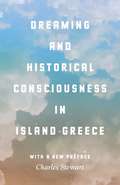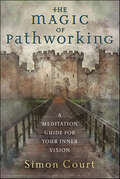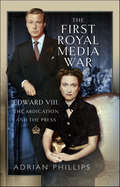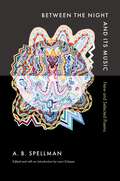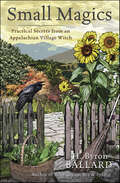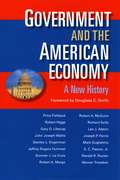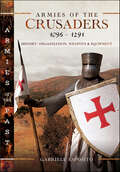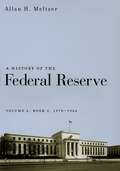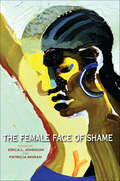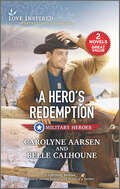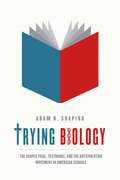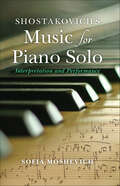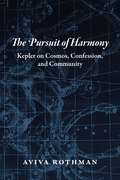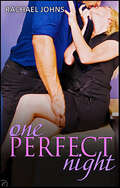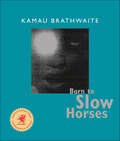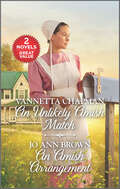- Table View
- List View
Out of the Sea: Today's Chincoteague Pony
by Lois SzymanskiFor generations, the ponies of Chincoteague, Virginia, have enchanted hearts and sparked imaginations. Made famous by the beloved Misty, these remarkable ponies live wild on Assateague Island. Each summer during the iconic Pony Penning celebration, the ponies swim to Chincoteague, come out of the bay, and parade to the carnival grounds, where foals are auctioned off to adoring pony enthusiasts. Features: • Heartwarming new stories of how these ponies are touching lives everywhere• Updated photographs that bring their beauty and spirit to life• Insider tips on experiencing Pony Penning and its unforgettable festivities• Insights into the evolution of the breed and how Chincoteague Ponies have become stars in the equestrian world• Dramatic rescue tales and the story of how Chincoteague Ponies helped combat a dangerous disease• Details on the people and organizations working tirelessly to preserve and support the breed Packed with rich history, personal anecdotes, and expert advice, this updated and expanded second edition of Out of the Sea is the ultimate tribute to these extraordinary ponies and the people who love them.
Dreaming and Historical Consciousness in Island Greece (Cultural Politics, Socioaesthetics, Beginnings Ser. #4)
by Charles StewartOn publication in 2012, Dreaming and Historical Consciousness in Island Greece quickly met wide acclaim as a gripping work that, according to the Times Literary Supplement, “offers a wholly new way of thinking about dreams in their social contexts.” It tells an extraordinary story of spiritual fervor, prophecy, and the ghosts of the distant past coming alive in the present. This new affordable paperback brings it to the wider audience that it deserves. Charles Stewart tells the story of the inhabitants of Kóronos, on the Greek island of Naxos, who, in the 1830s, began experiencing dreams in which the Virgin Mary instructed them to search for buried Christian icons nearby and build a church to house the ones they found. Miraculously, they dug and found several icons and human remains, and at night the ancient owners of them would speak to them in dreams. The inhabitants built the church and in the years since have experienced further waves of dreams and startling prophesies that shaped their understanding of the past and future and often put them at odds with state authorities. Today, Kóronos is the site of one of the largest annual pilgrimages in the Mediterranean. Telling this fascinating story, Stewart draws on his long-term fieldwork and original historical sources to explore dreaming as a mediator of historical change, while widening the understanding of historical consciousness and history itself.
The Magic of Pathworking: A Meditation Guide for Your Inner Vision
by Simon CourtMagical pathworking is the powerful process of using specific guided meditations to explore the unlimited spiritual energies that form the contours of our lives. This book guides you through a journey of unique pathworkings based on archetypal themes and helps you develop your inner work space with initial pathworkings that explore the influence of earth, air, fire, water and quintessence. Immerse yourself in thirteen additional pathworkings that bring your inner landscape into the light so that you can move forward with a deeper connection to the magic within you. The Magic of Pathworking also shows how to interpret and incorporate the events, symbols, and magical meanings of your experiences, creating a strong foundation for continuing transformation on your personal magical journey.
The First Royal Media War: Edward VIII, The Abdication and the Press
by Adrian PhillipsThe abdication crisis of 1936 demolished the wall of silent deference that had protected the British royal family from press comment and intrusion since the days of Queen Victoria. King Edward VIII was a child of the burgeoning age of media and the first celebrity monarch, but the immense personal popularity created by his charm and good looks was not enough to save him when he came into conflict with a government that embodied the conservative ethos of the time. Nor did the support of powerful media barons. In the United States William Randolph Hearst, who inspired Citizen Kane, dreamed of giving Britain an American Queen and maneuvered with Wallis Simpson to place her on the throne. In Britain the Anglo- Canadian newspaper magnate Lord Beaverbrook hoped to use the confrontation between the King and the government to force the prime minister, his bitter enemy Stanley Baldwin, out of power. Edward was blocked from broadcasting his case directly to the public, which was the source of deep resentment to him. The government treated the couple’s media initiatives as declarations of war and was prepared to respond savagely. The British press remained tactfully silent almost until the end of the crisis, but behind the scenes, a cold war was being fought. For the rest of his life, Edward fought to air his grievances against the ill-treatment to which he thought that he had been subjected. He believed that he had been forced to abdicate by a coalition of reactionaries grouped behind the Archbishop of Canterbury. Edward resented bitterly the ostracism to which he and Wallis were subjected by his brother and sister-in-law, King George VI and Queen Elizabeth, especially the refusal to grant his wife royal status. With sometimes farcical results, Edward tried to find authors who put over his side of the story. Beaverbrook supported Edward but tried to bend Edward’s quest to fit his own agenda. The establishment did its utmost to restrain Edward and maintain a discreet silence over the crisis, but gradually members of the royal court abandoned reticence and fought back. The abdication challenged the British monarchy as an institution. A large part of the legacy is today’s no-holds-barred media environment where the royal family's issues are fought in a ruthless glare of worldwide attention.
Between the Night and Its Music: New and Selected Poems (Wesleyan Poetry Series)
by A. B. SpellmanA. B. Spellman is an acclaimed American poet, music critic, and arts administrator. He is widely recognized as a leading figure in the Black Arts Movement of the 1960s and 1970s, a cultural and literary movement that emphasized Black identity, pride, and artistic expression. Between the Night and Its Music brings together A. B. Spellman's early work with a collection of powerful new poems. Spellman's literary career took flight in 1965 with his debut poetry collection, The Beautiful Days, which introduced his distinctive voice blending elements of jazz, blues, and African oral traditions. In 1966, Four Lives in the Bebop Business established Spellman as a respected music critic and scholar. It was a groundbreaking work that chronicled the lives and struggles of four influential jazz musicians. Spellman held senior positions at the National Endowment for the Arts for thirty years with lasting impact on arts funding for inner cities and rural and tribal communities. In addition to poems from The Beautiful Days (1965) and Things I Must Have Known (2008), this book contains a trove of new and uncollected poems, confirming Spellman's continued centrality to contemporary American literature. This is an essential volume for readers already familiar with Spellman, and an excellent introduction for new readers. Lauri Scheyer's introduction situates Spellman's work within jazz writing, Black Arts, and American poetry broadly.[sample text]THE TWISTa dancer's worldis walls, movementconfined: musicgod's last breath.rhythm: the last beating of his heart. a dancerfollows that sound, blindto its source, toward wallswith others. she cannot dance aloneshe thinks of thoughtas windows, as ice around the dancecan you break it? move
Small Magics: Practical Secrets from an Appalachian Village Witch
by H. Byron BallardYour hands-on, back-to-basics guide to building a magical practice.“Common-sense folk wisdom, remedies, and practices . . . and a welcome perspective that the magical world all around is not only accessible to us, it is part of us.” —Miles Batty, author of Teaching Witchcraft As if you’re having face-to-face lessons on her porch, H. Byron Ballard introduces you to the ways of magic, answering vital questions about what it is, why it matters, and how to do it. She teaches the mechanics and foundational skills of practice, offering no-nonsense techniques that practitioners of any skill level or tradition can use.Drawing from her many years as a practicing witch, Ballard demonstrates how to engage daily with the energy around you. She encourages you to experience magic with fresh eyes—whether you're a beginner or need to regain a beginner’s mind. This book provides grounding exercises, shielding methods, healing magic, insight on witchcraft tools, and more. Ballard offers everything you need to live a full, enchanted life in our deliciously magical world.“A down to earth, easy to read instruction manual filled with practical magical solutions all of which can be performed with items you already have on hand.” —Dorothy Morrison, author of Everyday Magic
What You Are Getting Wrong About Appalachia
by Elizabeth CatteAn antidote to bigotry and a &“perfect primer for readers seeking factual, realistic portrayals of the rural and working-class experience&” (Los Angeles Times). In 2016, headlines declared Appalachia ground zero for America&’s &“forgotten tribe&” of white working-class voters. Journalists flocked to the region to extract sympathetic profiles of families devastated by poverty, abandoned by establishment politics, and eager to consume cheap campaign promises. What You Are Getting Wrong About Appalachia is a frank assessment of America&’s recent fascination with the people and problems of the region. The book analyzes trends in contemporary writing on Appalachia, presents a brief history of Appalachia with an eye toward unpacking stereotypes, and provides examples of writing, art, and policy created by Appalachians as opposed to for Appalachians—ultimately offering a much-needed insider&’s perspective on the region. &“The most damning critique of Hillbilly Elegy.&” —New York Review of Books &“Succeeds in providing a richer, more complex view.&” —Publishers Weekly &“A necessary response to the bigotry against a much-maligned culture.&” —Chris Offutt, award-winning author of Code of the Hills
Government and the American Economy: A New History
by Price V. FishbackThe American economy has provided a level of well-being that has consistently ranked at or near the top of the international ladder. A key source of this success has been widespread participation in political and economic processes. In The Government and the American Economy, leading economic historians chronicle the significance of America’s open-access society and the roles played by government in its unrivaled success story. America’s democratic experiment, the authors show, allowed individuals and interest groups to shape the structure and policies of government, which, in turn, have fostered economic success and innovation by emphasizing private property rights, the rule of law, and protections of individual freedom. In response to new demands for infrastructure, America’s federal structure hastened development by promoting the primacy of states, cities, and national governments. More recently, the economic reach of American government expanded dramatically as the populace accepted stronger limits on its economic freedoms in exchange for the increased security provided by regulation, an expanded welfare state, and a stronger national defense.
Armies of the Crusaders, 1096–1291: History, Organization, Weapons and Equipment
by Gabriele EspositoGabriele Esposito provides a detailed coverage of the elite Military Orders, whose members combined the fervor of a religious brotherhood with elite military professionalism. The Crusades were among the most astonishing historical events that took place during the Middle Ages. After centuries of relative isolation following the fall of the Roman Empire, Western Europe looked again towards the Middle East in search of lands to conquer. Incited by the Church to believe that the Holy Land must be ‘liberated’ from its Muslim rulers (who had by then occupied it for centuries), and that to do so would bring spiritual salvation, many thousands from all over Christian Europe ‘took the cross’ and joined the Crusades. Led by some of the most illustrious personalities of the age, such as Richard the Lionheart and Frederick Barbarossa, they fought numerous campaigns and even founded new ‘Crusader states’, some of which lasted for almost two centuries. Gabriele Esposito gives an overview of the key events of these campaigns, from the First Crusade in 1096 to the fall of Acre, the last Christian stronghold in the Holy Land, in 1291. He analyzes the various contingents that made up the Crusader forces, describing their equipment and tactics and showing how they attempted to adapt to unfamiliar terrain and enemies. Included, of course, are the military orders (the Templar, Hospitaller and Teutonic knights) who combined the religious fervour of a monastic brotherhood with martial prowess, forming an elite core to the Christian forces. As usual, the informative text is lavishly illustrated with color photos depicting replica weapons and equipment in use.
Hang Time: My Life in Basketball
by Alan Eisenstock Elgin BaylorElgin Baylor&’s memoir of an epic all-star career in the NBA—during which he transformed basketball from a horizontal game to a vertical one—and his fights against racism during his career as a player and as general manager of the LA Clippers under the infamous Donald Sterling People think of Elgin Baylor as one of the greatest basketball players in the history of the game—and one of the NBA&’s first black superstars—but the full extent of his legacy stretches beyond his spectacular, game-changing shots and dunks. With startling symmetry, Baylor recounts his story: flying back and forth between the U.S. Army and the Lakers, his time as a central figure in the great Celtics-Lakers rivalry and how he helped break down color barriers in the sport, his 1964 All-Star game boycott, his early years as an executive for the New Orleans Jazz, and twenty-two years as general manager for the notorious L.A. Clippers and Donald Sterling, spent fighting to draft and sign young, black phenoms—only to be hamstrung by his boss at every turn. No one has seen the league change, and has worked to bring change, more than Baylor. Year after year, he continued to fight and persevere against racism. At the beginning of his career, he was forced to stay in separate hotel rooms. From those days to today&’s superstardom, he has had a front-row view of the game&’s elevation to one of America&’s favorite sports. For the first time, Elgin Baylor tells his full story and sets the record straight.
Looking for Sophie
by Roz Denny FoxOver a year ago Garnet Patton's young daughter disappeared without a trace, kidnapped by her ex-husband. And now a big-city cop thinks a little girl in rural Georgia might be Sophie.Yet Detective Julian Cavenaugh insists on proceeding with the utmost caution. The child he saw appeared healthy and happy and doted on by a loving father. Without proof that the girl is Garnet's daughter, Julian can't make false accusations against an innocent man. Or raise a desperate mother's hope. Especially when he's already emotionally involved.Garnet knows in her heart that the girl is Sophie. And that she's fallen for Julian when she never expected to feel anything again. But when they arrive in Georgia, they learn that the girl has vanished once more....
A History of the Federal Reserve: Book 2, 1970–1986
by Allan H. MeltzerAllan H. Meltzer’s critically acclaimed history of the Federal Reserve is the most ambitious, most intensive, and most revealing investigation of the subject ever conducted. Its first volume, published to widespread critical acclaim in 2003, spanned the period from the institution’s founding in 1913 to the restoration of its independence in 1951. This two-part second volume of the history chronicles the evolution and development of this institution from the Treasury–Federal Reserve accord in 1951 to the mid-1980s, when the great inflation ended. It reveals the inner workings of the Fed during a period of rapid and extensive change. An epilogue discusses the role of the Fed in resolving our current economic crisis and the needed reforms of the financial system.In rich detail, drawing on the Federal Reserve’s own documents, Meltzer traces the relation between its decisions and economic and monetary theory, its experience as an institution independent of politics, and its role in tempering inflation. He explains, for example, how the Federal Reserve’s independence was often compromised by the active policy-making roles of Congress, the Treasury Department, different presidents, and even White House staff, who often pressured the bank to take a short-term view of its responsibilities. With an eye on the present, Meltzer also offers solutions for improving the Federal Reserve, arguing that as a regulator of financial firms and lender of last resort, it should focus more attention on incentives for reform, medium-term consequences, and rule-like behavior for mitigating financial crises. Less attention should be paid, he contends, to command and control of the markets and the noise of quarterly data.At a time when the United States finds itself in an unprecedented financial crisis, Meltzer’s fascinating history will be the source of record for scholars and policy makers navigating an uncertain economic future.
The Female Face of Shame
by Erica L. Johnson and Patricia MoranThe female body, with its history as an object of social control, expectation, and manipulation, is central to understanding the gendered construction of shame. Through the study of 20th-century literary texts, The Female Face of Shame explores the nexus of femininity, female sexuality, the female body, and shame. It demonstrates how shame structures relationships and shapes women's identities. Examining works by women authors from around the world, these essays provide an interdisciplinary and transnational perspective on the representations, theories, and powerful articulations of women's shame.
Economics for Humans
by Julie A. NelsonAt its core, an economy is about providing goods and services for human well-being. But many economists and critics preach that an economy is something far different: a cold and heartless system that operates outside of human control. In this impassioned and perceptive work, Julie A. Nelson asks a compelling question: given that our economic world is something that we as humans create, aren’t ethics and human relationships—dimensions of a full and rich life—intrinsically part of the picture?Economics for Humans argues against the well-ingrained notion that economics is immune to moral values and distant from human relationships. Here, Nelson locates the impediment to a more considerate economic world in an assumption that is shared by both neoliberals and the political left. Despite their seemingly insurmountable differences, both make use of the metaphor, first proposed by Adam Smith, that the economy is a machine. This pervasive idea, Nelson argues, has blinded us to the qualities that make us work and care for one another—qualities that also make businesses thrive and markets grow. We can wed our interest in money with our justifiable concerns about ethics and social well-being. And we can do so if we recognize that an economy is not a machine, but a living thing in need of attention and careful tending. This second edition has been updated and refined throughout, with expanded discussions of many topics and a new chapter that investigates the apparent conflict between economic well-being and ecological sustainability. Further developing the main points of the first edition, Economics for Humans will continue to both invigorate and inspire readers to reshape the way they view the economy, its possibilities, and their place within it.
A Hero's Redemption (Military Heroes)
by Carolyne Aarsen Belle CalhouneHealing the cowboy soldierA Family for the Soldier by Carolyne Aarsen Grady Stillwater&’s Texas ranch needs his attention—and so does his brother's abandoned baby. But the injuries the former special ops soldier sustained in Afghanistan have skewered his confidence. Physical therapist Chloe Miner offers hope and guidance, but she&’s also hiding a secret. Chloe has a baby on the way, and she may need Grady every bit as much as he does her…Heart of a Soldier by Belle Calhoune When returning soldier Dylan Hart arrives in Texas to meet pen pal Holly Lynch, he's shocked to discover the woman he fell in love with has kept a very big secret. Dylan is hurt that Holly didn't confide in him, but he's committed to staying in town when her family hires him to help on their ranch. And as Dylan reconnects with Holly, he'll have to decide what matters most…2 Uplifting StoriesA Family for the Soldier and Heart of a Soldier
Trying Biology: The Scopes Trial, Textbooks, and the Antievolution Movement in American Schools
by Adam R. ShapiroIn Trying Biology, Adam R. Shapiro convincingly dispels many conventional assumptions about the 1925 Scopes “monkey” trial. Most view it as an event driven primarily by a conflict between science and religion. Countering this, Shapiro shows the importance of timing: the Scopes trial occurred at a crucial moment in the history of biology textbook publishing, education reform in Tennessee, and progressive school reform across the country. He places the trial in this broad context—alongside American Protestant antievolution sentiment—and in doing so sheds new light on the trial and the historical relationship of science and religion in America. For the first time we see how religious objections to evolution became a prevailing concern to the American textbook industry even before the Scopes trial began. Shapiro explores both the development of biology textbooks leading up to the trial and the ways in which the textbook industry created new books and presented them as “responses” to the trial. Today, the controversy continues over textbook warning labels, making Shapiro’s study—particularly as it plays out in one of America’s most famous trials—an original contribution to a timely discussion.
Shostakovich's Music for Piano Solo: Interpretation and Performance (Russian Music Studies)
by Sofia MoshevichThe piano works of Dmitri Shostakovich (1906–1975) are among the most treasured musical compositions of the 20th century. In this volume, pianist and Russian music scholar Sofia Moshevich provides detailed interpretive analyses of the ten major piano solo works by Shostakovich, carefully noting important stylistic details and specific ways to overcome the numerous musical and technical challenges presented by the music. Each piece is introduced with a brief historic and structural description, followed by an examination of such interpretive aspects as tempo, phrasing, dynamics, voice balance, pedaling, and fingering. This book will be an invaluable resource for students, pedagogues, and performers of Shostakovich's piano solos.
Marrying the Boss
by Megan KellyAll his life Mark Collins has been fighting for a place to belong. Now just when he thinks the hard-earned family business is within reach, his adoptive grandfather's will has named a challenger.Leanne Fairbanks belongs in Collins Company as much as Mark does?and she's just as determined to become its next CEO. Until her handsome rival starts arousing feelings that have nothing to do with business. With a lot more than who's going to be boss at issue, Leanne has to decide whether winning the battle will lose her the war?especially when it's her heart at stake....
The Pursuit of Harmony: Kepler on Cosmos, Confession, and Community
by Aviva RothmanA committed Lutheran excommunicated from his own church, a friend to Catholics and Calvinists alike, a layman who called himself a “priest of God,” a Copernican in a world where Ptolemy still reigned, a man who argued at the same time for the superiority of one truth and the need for many truths to coexist—German astronomer Johannes Kepler was, to say the least, a complicated figure. With The Pursuit of Harmony, Aviva Rothman offers a new view of him and his achievements, one that presents them as a story of Kepler’s attempts to bring different, even opposing ideas and circumstances into harmony. Harmony, Rothman shows, was both the intellectual bedrock for and the primary goal of Kepler’s disparate endeavors. But it was also an elusive goal amid the deteriorating conditions of his world, as the political order crumbled and religious war raged. In the face of that devastation, Kepler’s hopes for his theories changed: whereas he had originally looked for a unifying approach to truth, he began instead to emphasize harmony as the peaceful coexistence of different views, one that could be fueled by the fundamentally nonpartisan discipline of mathematics.
Korean Slanguage: A Fun Visual Guide to Korean Terms and Phrases
by Mike EllisJust in time for the 2018 Olympics, Korean Slanguage provides translations and pronunciation guides for approximately 300 English words and phrases. Just use the pronunciation guide to say them out loud, and soon you’ll be speaking basic Korean words and phrases like “It’s cool” (Show Not Dad) and “Are you okay?” (Quinn Send Eye Oh?). Fun and helpful illustrations paired with easy English words to pronounce will have you speaking Korean in no time. Both Hangul and romanized versions of the Korean terms are provided.
The Wartime President: Executive Influence and the Nationalizing Politics of Threat (Chicago Ser. On International And Domestic Institutions Ser.)
by William G. Howell Saul P. Jackman Jon C. Rogowski“It is the nature of war to increase the executive at the expense of the legislative authority,” wrote Alexander Hamilton in the Federalist Papers. The balance of power between Congress and the president has been a powerful thread throughout American political thought since the time of the Founding Fathers. And yet, for all that has been written on the topic, we still lack a solid empirical or theoretical justification for Hamilton’s proposition. For the first time, William G. Howell, Saul P. Jackman, and Jon C. Rogowski systematically analyze the question. Congress, they show, is more likely to defer to the president’s policy preferences when political debates center on national rather than local considerations. Thus, World War II and the post-9/11 wars in Afghanistan and Iraq significantly augmented presidential power, allowing the president to enact foreign and domestic policies that would have been unattainable in times of peace. But, contrary to popular belief, there are also times when war has little effect on a president’s influence in Congress. The Vietnam and Gulf Wars, for instance, did not nationalize our politics nearly so much, and presidential influence expanded only moderately. Built on groundbreaking research, The Wartime President offers one of the most significant works ever written on the wartime powers presidents wield at home.
One Perfect Night
by Rachael JohnsPeppa Grant's fellow employees may call their new CEO Mr. McSexy, but she's also heard that he's aloof and distant. Cameron McCormac certainly seems cold toward Christmas when she meets him at the company's annual party...but he's also the sexiest man Peppa has ever seen. And when he offers to forgive the damage she accidentally caused to his expensive car in exchange for accompanying him to his family's holiday get-together, she agrees. Cameron needs a date to the family party to get his matchmaking relatives off his back. Their chemistry is instant and undeniable, leading to an incredible one-night stand. But Peppa wants love and family, while Cameron's only interested in temporary pleasure. When their relationship takes an unexpectedly serious turn, will he run the other way-or will he give love a second chance? 58,000 words
Born to Slow Horses (Wesleyan Poetry Series)
by Kamau BrathwaiteWinner of the Griffin International Poetry Prize (2006)Kamau Brathwaite's Born to Slow Horses is a series of poetic meditations on islands and exile, language and ritual, and the force of personal and historical passions and griefs. These poems are haunted, figuratively and literally, by spirits of the African diaspora and drenched in the colors, sounds, and rhythms of the islands. But they also encompass the world of the exile and return, and the events of 9/11 in New York City. Brathwaite is one of the foremost voices in postcolonial inquiry and expression, and his poetry is densely rooted and expansive.Using his unusual "sycorax" signature typography and spelling, Brathwaite brings a cultural specificity, with distinct accents, sonic gestures, and pronunciations, into his pages—making them new, exciting, and rich in nuances.
The Baby Barter and The Marriage Bargain
by Patty Smith Hall Angel MooreA practical arrangementThe Baby Barter by Patty Smith Hall Sheriff Mack Worthington isn't sure army nurse Thea Miller—whose actions once hurt him badly—is committed to raising her late sister&’s baby. And a judge may never approve a single-parent adoption for either of them. But what if they got married? It would be a marriage in name only. Could their pretend family become the real one they've both been longing for?The Marriage Bargain by Angel Moore Lily Warren's new hat shop is her ticket to self-reliance. But when her landlord, Edward Stone, bursts into her rooms to rescue her from a fire, Lily's reputation is tarnished. With an orphaned niece who needs a mother, Edward believes a marriage of convenience is the answer to his and Lily's problems. Until he develops feelings for his new wife…
An Unlikely Amish Match and An Amish Arrangement
by Jo Ann Brown Vannetta ChapmanAn Unlikely Amish Match by Vannetta ChapmanSusannah Beiler is determined to protect the other young marriageable Amish women from falling for the new bad boy in town by pretending to date Micah Fisher herself! Their deal is simple: she’ll keep him company if he stays away from her friends. It’s not long before she starts to see there’s more to Micah than his reputation…An Amish Arrangement by Jo Ann BrownDays before Jeremiah Stoltzfus closes the deal on his new farm in Harmony Creek, Mercy Bamberger claims the property is hers, promised by her late grossdawdi. Jeremiah can’t turn out the single mom and her daughter, nor can he leave. His solution: temporarily sharing the farm until ownership is settled. But living beside the handsome Amish farmer has Mercy longing for love and a forever family.

